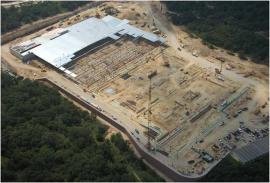
The growing demands of Microsoft’s core customers necessitate dramatic alterations in the way Microsoft’s data centers are set up. Before their server racks were replaced one at a time, Microsoft’s new solution to server management is to truck in servers in sealed shipping containers and set them up without even taking them out. If a core number of servers start to fail within the shipping container it is removed, returned to the manufacturer, and replaced. This strategy helps Microsoft manage the desires of its consumer base for search, video, photo services and other services provided under the Microsoft Online umbrella. Although Microsoft’s method of server management makes the process of running data centers more efficient, thereby saving costs and power, Microsoft still has to contend with old networking protocols. It’s counting on the industry to innovate in these areas.
[via Boing Boing]















Hasn’t Sun been doing this for… oh… FIVE YEARS NOW?
http://www.sun.com/products/sunmd/s20/index.jsp
Isn’t this Sun’s Blackbox technology as envisioned originally by the Internet Archive?
…Microsoft still has to contend with old networking protocols. It’s counting on the industry to innovate in these areas.
Wasn’t the whole argument that Microsoft shouldn’t be subject to antitrust enforcement, was that It was so damn innovative? Which company is going to develop a new protocol unsupported by microsoft?
I have seen a build that used a new trash container where 12 blade racks were installed back to back with a water jacket, for cooling, slid in between each pair and hooked up for serial flow through. Each of the racks were loaded with a full contingent of blades running intel 32 bit duel cores. The container was fixed to the cement floor of the company’s parking garage. There power,water,and fiber optics were connected. The hot water was then used in the hot water needs of the building using alot less energy to heat it to temp.Loaded with Unix server software it worked really well. I guess a pre-built and pre-loaded system as described in the article would be the next generation. You drop it, anchor it and hook up utilities, cool. A one day job to begin boot sequence. It took us three weeks before loading the os.
“Microsoft still has to contend with old networking protocols. It’s counting on the industry to innovate in these areas.”
…because dear god, they can’t innovate there themselves.
of course if Microsoft were to suggest a new protocol all the linux zealots would be screaming out that it’s EVIL and proprietary and should under no circumstances be supported.
I wonder what the users/server ratio is across the whole internet? Could you forsee a time where it gets near 1:1 when data\CPU hungry applictions get put server side? (eg. Microsofts new photosynth app)
Also, when all these servers meet “end of life”, could there be cheap racks of servers going on ebay? Even if each individual PC is very old, a whole rack of old PC’s could still be usefull for many tasks which can be effectively distributed..
Combine this with shipping container architecture and all of the sudden the corporate world gets more modular.
So the difference to what SUN is doing is that, when core set of servers in the container fail, those components aren’t replaced, but the whole container gets replaced… how is that more (cost)efficient?
That and, isn’t SUNS container supposed to be a temporary solution until additional space is created/build in an already existing datacenter?
This picture looks like a gigantic PCMCIA slot…